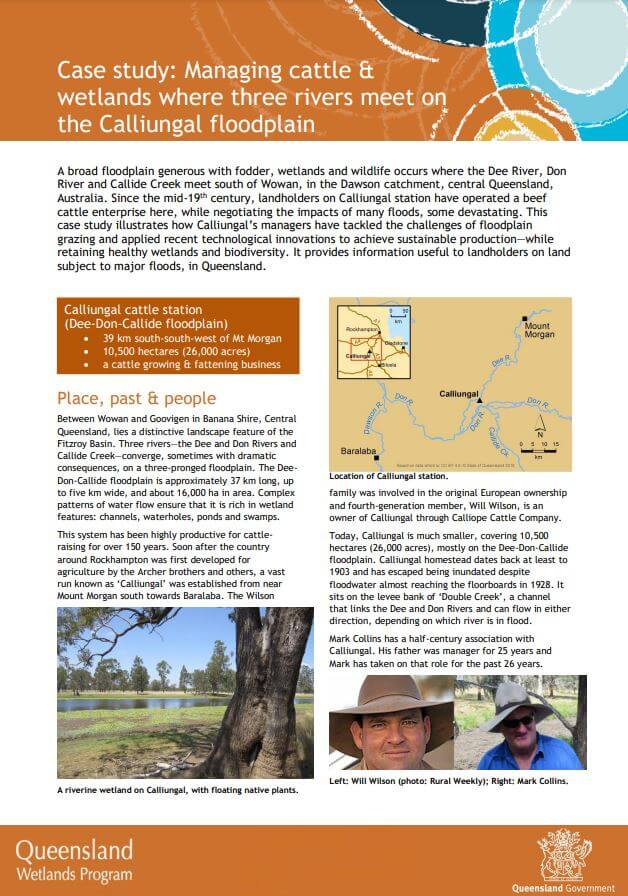Resources library - Land Managers
Land Managers Resources
Improving run-off
Restoring flooded cotton farm

Arcturus Downs, located near Springsure, is one of many cotton farms in the Fitzroy Basin that sustained significant damage to its fields and infrastructure through wet season flooding in recent years.
Case Study
Calliungal Wetland Case Study

A Queensland Government case study focusing on managing cattle and wetlands where three rivers meet; on the Calliungal floodplain.
Improving productivity – bringing rotational grazing goal to fruition
Improving productivity - bringing rotational grazing goal to fruition

When Kellie Humble’s father Rob Jenkinson tragically lost his life while retrieving cattle from a neighbouring paddock, it could have also meant the end of his improvement plans for Radleigh, the property he owned with wife Julie.
Regenerative Agriculture case study
RegenAG - farming the way nature intended

Long term degradation of fertile soil in Australia, loss of arable land, diminishing profitability and reduced nutritional levels in produced food are all challenges faced by agricultural producers. Regenerative agriculture techniques however, help to not only preserve soils but also improve them and may hold some of the answers needed to help safeguard the future of primary producers. FBA's first peer-to-peer regenerative agriculture model for agricultural extension has been a resounding success.
Long-term restoration – improving land condition
Long-term restoration - improving land condition

Ross Christiansen and his son Garth were some of the first landholders to partner with Fitzroy Basin Association Inc. to trial a new approach to restoring the condition of grazing land.
Gully Erosion in the Fitzroy Basin – case studies
Gully Erosion in the Fitzroy Basin

Erosion from gullies is considered one of the greatest risks to the health of the Great Barrier Reef. Through funding from the Australian Government's Reef Program, Fitzroy Basin Association Inc. (FBA) has worked with graziers across the region to repair gullies using innovative approaches. FBA has worked with six graziers with actively eroding gullies, located in high risk sediment areas identified through FBA's Sediment Risk Mapping, to complete site specific gully erosion projects in our region. Follow their journey and hear how they went about repairing gullies on their properties.
Gully Erosion in the Fitzroy Basin – case studies
Gully Erosion in the Fitzroy Basin - 12 months on

Erosion from gullies is considered one of the greatest risks to the health of the Great Barrier Reef. Through funding from the Australian Government's Reef Program, Fitzroy Basin Association has worked with graziers in high risk sediment areas to implement individually tailored remediation works. 12 months on, we revisit 3 landholders to find out how their erosion sites are recovering, how restoration works have withstood rain events and what they've achieved for their property and future.
Reducing Sediment Loss in the Fitzroy Basin
Remote Livestock Management Systems Case Study

Three central Queensland grazing enterprises have trialled an innovative Remote Livestock Management System focusing on reducing sediment loss and increasing productivity. The trail was supported by Fitzroy Basin Association through funding from the Queensland Government’s Reef Water Quality Program Innovation Fund. All project participants were located in the Fitzroy Basin on different land types and with different management systems in place. This case study explores each participant’s experience with the RLMS system.
Wetland case study
Fitzroy coastal floodplain case study

This case study was created by the Department of Environment and Resource Management Aquatic Ecosystem Health Science Integration and Capacity Building Team as part of the Queensland Wetlands Program. The purpose of this conceptual modelling case study is to synthesise and present information on the values of the Fitzroy estuarine floodplain wetland pools. In particular, the study examines how physical and biological connectivity across the Fitzroy delta landscape drives the ecological functioning of the wetland pools.
Riparian fencing case study
Maximising grazing areas by using smaller paddocks

It might seem like a simple change, but by installing riparian fencing and creating smaller paddocks that are segregated according to land type, grazier Jim Curran and his wife Janet are able to manage their herd better and maximise the use of previously under-used pasture. And they are encouraging others to do the same.








